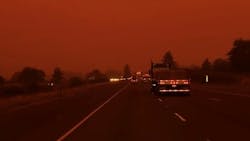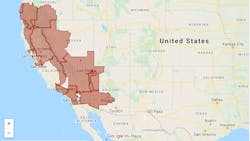FMCSA issues emergency declaration in response to wildfires
The Federal Motor Carrier Safety Administration (FMCSA) has issued an extended state emergency declaration for California, Oregon and Washington in direct response to the widespread wildfires and dangerous conditions in the region. There are concerns that those fires could worsen or that others will start due to the hot, dry, windy conditions, and dry thunderstorms across the West Coast.
FMCSA's extension covers commercial vehicles that are "providing direct assistance supporting emergency relief efforts [by] transporting supplies, goods, equipment and fuel, and transporting persons into and from the affected states, or providing other assistance in the form of emergency services during the emergency in the affected states from the wildfires."
Some 14,000 firefighters are battling about 30 major wildfires across California and neighboring states this week as wind conditions continue to spread the flames, which have now burned more than 2.5 million acres.
Along with California, the fires have spread into Oregon, Nevada and Washington, affecting travel along major freight corridors including I-5, I-10, I-80 and other main roads in the West. On Thursday morning, Sept. 10, the National Weather Service had issued dense smoke advisories for several Eastern California counties and Western Nevada counties. The advisories noted that the smoke is leading to unhealthy air quality and reduced visibility.
There were reports in Oregon of drivers abandoning tractor-trailers on I-5 as conditions worsened along the California border. The Oregon Department of Transportation was asking truck drivers to return to their vehicles and move them before the state towed the trucks.
“Yesterday, and overnight, wind conditions allowed many fires to grow significantly with extreme fire behavior,” Cal Fire spokesman Daniel Berlant said in a Sept. 9 statewide update. “While containment on many of last month’s lightning fires grows closer, several new wildfires ignited and were fanned by strong gusty winds.”
The NWS warned that the smoke might impact air quality throughout California and bordering states through the weekend. In Oregon, the NWS issued four red flag warnings in less than 12 hours from late Wednesday night into Thursday morning.
“A change from the current easterly wind pattern to a westerly wind will take place late today and persist through the weekend,” according to a special weather statement issued early on Sept. 10. “This will begin to transport smoke from the large fires west of the Cascades across Eastern Oregon and Washington this afternoon and overnight. The combination of light surface winds and night time inversions will tend to trap smoke near the surface. Air quality is expected to deteriorate and could become unhealthy or even hazardous in some areas through the weekend. Central Oregon is most likely to be impacted due to the proximity to the fires.”
Red flag warnings and air quality alerts were also issued in Washington by the NWS on Sept. 9 and 10. Red flag warnings mean that critical fire weather conditions are either imminent or occurring now, and any fires that develop are expected to spread quickly. “A dry and unstable air mass with warm temperatures can contribute to active fire behavior,” according to an NWS bulletin issued for portions of western Washington.
Specific road closures are being posted by state departments of transportation in California, Nevada, Oregon and Washington.
Catharine Conway contributed to this report.
About the Author
Josh Fisher
Editor-in-Chief
Editor-in-Chief Josh Fisher has been with FleetOwner since 2017. He covers everything from modern fleet management to operational efficiency, artificial intelligence, autonomous trucking, alternative fuels and powertrains, regulations, and emerging transportation technology. Based in Maryland, he writes the Lane Shift Ahead column about the changing North American transportation landscape.
Catharine Conway
Digital Editor
Catharine Conway is a past FleetOwner digital editor who wrote for the publication from 2018 to 2022.



